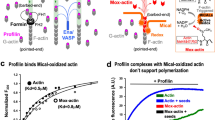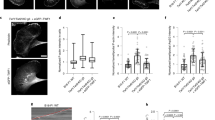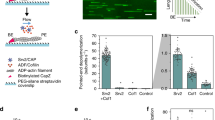Abstract
How instructive cues present on the cell surface have their precise effects on the actin cytoskeleton is poorly understood. Semaphorins are one of the largest families of these instructive cues and are widely studied for their effects on cell movement, navigation, angiogenesis, immunology and cancer1. Semaphorins/collapsins were characterized in part on the basis of their ability to drastically alter actin cytoskeletal dynamics in neuronal processes2, but despite considerable progress in the identification of semaphorin receptors and their signalling pathways3, the molecules linking them to the precise control of cytoskeletal elements remain unknown. Recently, highly unusual proteins of the Mical family of enzymes have been found to associate with the cytoplasmic portion of plexins, which are large cell-surface semaphorin receptors, and to mediate axon guidance, synaptogenesis, dendritic pruning and other cell morphological changes4,5,6,7. Mical enzymes perform reduction–oxidation (redox) enzymatic reactions4,5,8,9,10 and also contain domains found in proteins that regulate cell morphology4,11. However, nothing is known of the role of Mical or its redox activity in mediating morphological changes. Here we report that Mical directly links semaphorins and their plexin receptors to the precise control of actin filament (F-actin) dynamics. We found that Mical is both necessary and sufficient for semaphorin–plexin-mediated F-actin reorganization in vivo. Likewise, we purified Mical protein and found that it directly binds F-actin and disassembles both individual and bundled actin filaments. We also found that Mical utilizes its redox activity to alter F-actin dynamics in vivo and in vitro, indicating a previously unknown role for specific redox signalling events in actin cytoskeletal regulation. Mical therefore is a novel F-actin-disassembly factor that provides a molecular conduit through which actin reorganization—a hallmark of cell morphological changes including axon navigation—can be precisely achieved spatiotemporally in response to semaphorins.
This is a preview of subscription content, access via your institution
Access options
Subscribe to this journal
Receive 51 print issues and online access
$199.00 per year
only $3.90 per issue
Buy this article
- Purchase on Springer Link
- Instant access to full article PDF
Prices may be subject to local taxes which are calculated during checkout




Similar content being viewed by others
References
Tran, T. S., Kolodkin, A. L. & Bharadwaj, R. Semaphorin regulation of cellular morphology. Annu. Rev. Cell Dev. Biol. 23, 263–292 (2007)
Luo, Y., Raible, D. & Raper, J. A. Collapsin: a protein in brain that induces the collapse and paralysis of neuronal growth cones. Cell 75, 217–227 (1993)
Zhou, Y., Gunput, R. A. & Pasterkamp, R. J. Semaphorin signaling: progress made and promises ahead. Trends Biochem. Sci. 33, 161–170 (2008)
Terman, J. R., Mao, T., Pasterkamp, R. J., Yu, H. H. & Kolodkin, A. L. MICALs, a family of conserved flavoprotein oxidoreductases, function in plexin-mediated axonal repulsion. Cell 109, 887–900 (2002)
Schmidt, E. F., Shim, S. O. & Strittmatter, S. M. Release of MICAL autoinhibition by semaphorin-plexin signaling promotes interaction with collapsin response mediator protein. J. Neurosci. 28, 2287–2297 (2008)
Beuchle, D., Schwarz, H., Langegger, M., Koch, I. & Aberle, H. Drosophila MICAL regulates myofilament organization and synaptic structure. Mech. Dev. 124, 390–406 (2007)
Kirilly, D. et al. A genetic pathway composed of Sox14 and Mical governs severing of dendrites during pruning. Nature Neurosci. 12, 1497–1505 (2009)
Siebold, C. et al. High-resolution structure of the catalytic region of MICAL (molecule interacting with CasL), a multidomain flavoenzyme-signaling molecule. Proc. Natl Acad. Sci. USA 102, 16836–16841 (2005)
Nadella, M., Bianchet, M. A., Gabelli, S. B., Barrila, J. & Amzel, L. M. Structure and activity of the axon guidance protein MICAL. Proc. Natl Acad. Sci. USA 102, 16830–16835 (2005)
Gupta, N. & Terman, J. R. in Flavins and Flavoproteins 2008 (eds Frago, S., Gómez-Moreno, C. & Medina, M.) 345–350 (Proc. 16th Int. Symp. Flavins Flavoproteins, Prensas Univ. Zaragoza, 2008)
Suzuki, T. et al. MICAL, a novel CasL interacting molecule, associates with vimentin. J. Biol. Chem. 277, 14933–14941 (2002)
Tilney, L. G. & DeRosier, D. J. How to make a curved Drosophila bristle using straight actin bundles. Proc. Natl Acad. Sci. USA 102, 18785–18792 (2005)
Sutherland, J. D. & Witke, W. Molecular genetic approaches to understanding the actin cytoskeleton. Curr. Opin. Cell Biol. 11, 142–151 (1999)
Turner, C. M. & Adler, P. N. Distinct roles for the actin and microtubule cytoskeletons in the morphogenesis of epidermal hairs during wing development in Drosophila . Mech. Dev. 70, 181–192 (1998)
Tilney, L. G., Connelly, P. S., Vranich, K. A., Shaw, M. K. & Guild, G. M. Actin filaments and microtubules play different roles during bristle elongation in Drosophila . J. Cell Sci. 113, 1255–1265 (2000)
Guild, G. M., Connelly, P. S., Vranich, K. A., Shaw, M. K. & Tilney, L. G. Actin filament turnover removes bundles from Drosophila bristle cells. J. Cell Sci. 115, 641–653 (2002)
Geng, W., He, B., Wang, M. & Adler, P. N. The tricornered gene, which is required for the integrity of epidermal cell extensions, encodes the Drosophila nuclear DBF2-related kinase. Genetics 156, 1817–1828 (2000)
Fan, J. et al. The organization of F-actin and microtubules in growth cones exposed to a brain-derived collapsing factor. J. Cell Biol. 121, 867–878 (1993)
Sánchez-Soriano, N. & Prokop, A. The influence of pioneer neurons on a growing motor nerve in Drosophila requires the neural cell adhesion molecule homolog FasciclinII. J. Neurosci. 25, 78–87 (2005)
Fan, J. & Raper, J. A. Localized collapsing cues can steer growth cones without inducing their full collapse. Neuron 14, 263–274 (1995)
Dent, E. W., Barnes, A. M., Tang, F. & Kalil, K. Netrin-1 and semaphorin 3A promote or inhibit cortical axon branching, respectively, by reorganization of the cytoskeleton. J. Neurosci. 24, 3002–3012 (2004)
Kapfhammer, J. P. & Raper, J. A. Collapse of growth cone structure on contact with specific neurites in culture. J. Neurosci. 7, 201–212 (1987)
Campbell, D. S. et al. Semaphorin 3A elicits stage-dependent collapse, turning, and branching in Xenopus retinal growth cones. J. Neurosci. 21, 8538–8547 (2001)
Fenstermaker, V., Chen, Y., Ghosh, A. & Yuste, R. Regulation of dendritic length and branching by semaphorin 3A. J. Neurobiol. 58, 403–412 (2004)
Liu, Y. & Halloran, M. C. Central and peripheral axon branches from one neuron are guided differentially by Semaphorin3D and transient axonal glycoprotein-1. J. Neurosci. 25, 10556–10563 (2005)
Sakai, J. A. & Halloran, M. C. Semaphorin 3d guides laterality of retinal ganglion cell projections in zebrafish. Development 133, 1035–1044 (2006)
Tosney, K. W. & Landmesser, L. T. Growth cone morphology and trajectory in the lumbosacral region of the chick embryo. J. Neurosci. 5, 2345–2358 (1985)
Broadie, K. et al. From growth cone to synapse: the life history of the RP3 motor neuron. Dev. Suppl. 227–238 (1993)
Godement, P., Wang, L. C. & Mason, C. A. Retinal axon divergence in the optic chiasm: dynamics of growth cone behavior at the midline. J. Neurosci. 14, 7024–7039 (1994)
Murray, M. J., Merritt, D. J., Brand, A. H. & Whitington, P. M. In vivo dynamics of axon pathfinding in the Drosophila CNS: a time-lapse study of an identified motorneuron. J. Neurobiol. 37, 607–621 (1998)
Acknowledgements
We thank C. Cowan, M. Rosen and T. Südhof for comments on drafts of our manuscript and M. Bailey, C. Gilpin, H. He, T. Januszewski, H. Krämer, W. Lin, T. Wedgeworth, X. Zhang and the University of Texas Southwestern Electron Microscopy Core Facility for discussions and assistance. We also thank the Bloomington, Harvard and Japanese stock centres for flies and H. Aberle, L. Cooley, C. Goodman, A. Kolodkin, B. Lee, L. Luo, J. Merriam and X. Zhang for flies and/or reagents. This work was supported by the US National Institute of Mental Health (MH085923) and a Basil O’Connor Starter Scholar Research Award to J.R.T. J.R.T. is a Klingenstein Fellow and the Rita C. and William P. Clements, Jr, Scholar in Medical Research.
Author Contributions All authors contributed critical reagents, discussed the results and commented on the manuscript; R.-J.H., U.Y., J.Y., H.W., T.Y. and J.R.T. performed experiments, collected and analysed data, and prepared the manuscript; and J.R.T. oversaw all aspects of the project and wrote the paper.
Author information
Authors and Affiliations
Corresponding author
Ethics declarations
Competing interests
The authors declare no competing financial interests.
Supplementary information
Supplementary Information
This file contains Supplementary Figures S1-S21 with Legends, Supplementary Methods, and Supplementary References. (PDF 11167 kb)
Rights and permissions
About this article
Cite this article
Hung, RJ., Yazdani, U., Yoon, J. et al. Mical links semaphorins to F-actin disassembly. Nature 463, 823–827 (2010). https://doi.org/10.1038/nature08724
Received:
Accepted:
Issue Date:
DOI: https://doi.org/10.1038/nature08724
This article is cited by
-
Mical modulates Tau toxicity via cysteine oxidation in vivo
Acta Neuropathologica Communications (2022)
-
MICALL2 as a substrate of ubiquitinase TRIM21 regulates tumorigenesis of colorectal cancer
Cell Communication and Signaling (2022)
-
Phosphorylation of MICAL2 by ARG promotes head and neck cancer tumorigenesis by regulating skeletal rearrangement
Oncogene (2022)
-
Profilin and Mical combine to impair F-actin assembly and promote disassembly and remodeling
Nature Communications (2021)
-
Cerebrospinal fluid proteome shows disrupted neuronal development in multiple sclerosis
Scientific Reports (2021)
Comments
By submitting a comment you agree to abide by our Terms and Community Guidelines. If you find something abusive or that does not comply with our terms or guidelines please flag it as inappropriate.



